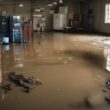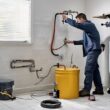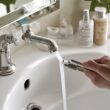Sewage backup cleanup typically costs between $1,000 and $3,000, depending on the damage severity and repairs needed. Common causes include clogged pipes and damaged sewer lines. You’ll likely pay $200 to $500 for a professional inspection to assess the situation accurately. Cleanup covers water removal, debris disposal, and disinfection, while restoration may involve replacing flooring, drywall, and insulation. Acting promptly and maintaining your system can reduce expenses. Understanding these details helps you plan your next steps effectively.
Common Causes and Initial Assessment Costs
Before you can address a sewage backup, it’s important to understand the common causes and the costs involved in the initial assessment.
Sewage backups often stem from clogged pipes, tree root intrusion, or damaged sewer lines. Heavy rains and outdated plumbing systems can also contribute.
When you hire a professional for the initial assessment, they inspect your property using cameras and other tools to pinpoint the problem. This evaluation typically costs between $200 and $500, depending on your location and the complexity.
Knowing these factors helps you plan financially and take control of the restoration process efficiently.
Breakdown of Cleanup and Restoration Expenses
When dealing with sewage backup cleanup, you’ll face a range of expenses that vary based on the extent of the damage and the specific services required.
Initial cleanup typically includes water extraction, debris removal, and disinfection, often costing between $1,000 and $3,000.
Restoration expenses cover repairing or replacing damaged flooring, drywall, and insulation, which can add several thousand dollars depending on materials and labor.
Additional costs may arise from mold remediation if moisture lingers after cleanup.
Understanding this breakdown helps you anticipate the financial impact and plan accordingly, ensuring you regain control over your property effectively and efficiently.
Strategies to Minimize Sewage Backup Cleanup Costs
Understanding the different costs involved in sewage backup cleanup and restoration helps you identify where you can take steps to reduce expenses. Start by acting quickly to prevent further damage, which often increases costs.
Regularly maintain your plumbing and sewer lines to avoid backups. Use protective gear and remove salvageable items yourself to lower labor fees.
When hiring professionals, request clear estimates and compare service providers to guarantee competitive pricing. Also, check if your insurance covers sewage backups to offset costs.
Being proactive and informed gives you more control and helps minimize cleanup expenses efficiently.
Frequently Asked Questions
How Long Does Sewage Backup Cleanup Typically Take?
Cleanup usually takes one to three days, depending on damage severity. You’ll want professionals to act fast, ensuring thorough sanitation so you can quickly get back to your life without worrying about health risks or lingering odors.
Is Sewage Backup Covered by Standard Homeowners Insurance?
Standard homeowners insurance usually doesn’t cover sewage backup unless you add specific coverage. You’ll want to check your policy and consider a rider to protect yourself, so you’re not caught off guard when disaster strikes.
What Health Risks Are Associated With Sewage Backups?
You face risks like infections, respiratory issues, and skin irritations from bacteria and viruses in sewage backups. Don’t ignore it—cleaning promptly protects your health and keeps your home safe from dangerous contaminants.
Can I Perform Sewage Cleanup Myself Safely?
You can’t safely handle sewage cleanup yourself—it’s hazardous and needs specialized gear. To protect your health and freedom, hire professionals who’ll properly disinfect, remove contaminants, and prevent long-term damage in your home.
What Equipment Is Used in Professional Sewage Cleanup?
You’ll need protective gear like gloves, boots, respirators, and coveralls. Pros use pumps, wet vacuums, industrial fans, and disinfectants to remove sewage and dry areas efficiently—equipment you probably don’t have or want to handle yourself.






